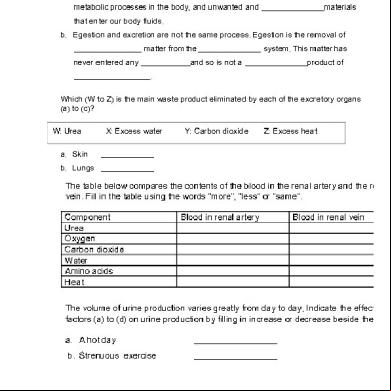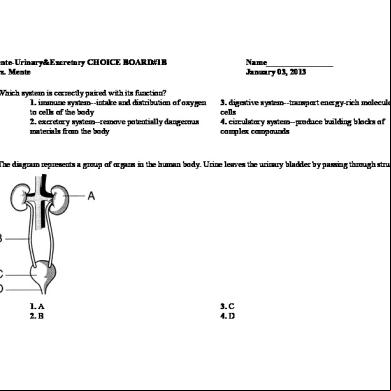Excretory Organs 28406k
This document was ed by and they confirmed that they have the permission to share it. If you are author or own the copyright of this book, please report to us by using this report form. Report 2z6p3t
Overview 5o1f4z
& View Excretory Organs as PDF for free.
More details 6z3438
- Words: 829
- Pages: 4
Excretory organs The primary excretory organ in fishes, as in other vertebrates, is the kidney. In fishes some excretion also takes place in the digestive tract, skin, and especially the gills (where ammonia is given off). Compared with land vertebrates, fishes have a special problem in maintaining their internal environment at a constant concentration of water and dissolved substances, such as salts. Proper balance of the internal environment (homeostasis) of a fish is in a great part maintained by the excretory system, especially the kidney. The kidney, gills, and skin play an important role in maintaining a fish’s internal environment and checking the effects of osmosis. Marine fishes live in an environment in which the water around them has a greater concentration of salts than they can have inside their body and still maintain life. Freshwater fishes, on the other hand, live in water with a much lower concentration of salts than they require inside their bodies. Osmosis tends to promote the loss of water from the body of a marine fish and absorption of water by that of a freshwater fish. Mucus in the skin tends to slow the process but is not a sufficient barrier to prevent the movement of fluids through the permeable skin. When solutions on two sides of a permeable membrane have different concentrations of dissolved substances, water will through the membrane into the more concentrated solution, while the dissolved chemicals move into the area of lower concentration (diffusion).
Generalized osmotic regulation in freshwater and marine teleost fishes. Encyclopædia Britannica, Inc.
The kidney of freshwater fishes is often larger in relation to body weight than that of marine fishes. In both groups the kidney excretes wastes from the body, but the kidney of freshwater fishes also excretes large amounts of
water, counteracting the water absorbed through the skin. Freshwater fishes tend to lose salt to the environment and must replace it. They get some salt from their food, but the gills and skin inside the mouth actively absorb salt from water ed through the mouth. This absorption is performed by special cells capable of moving salts against the diffusion gradient. Freshwater fishes drink very little water and take in little water with their food. Marine fishes must conserve water, and therefore their kidneys excrete little water. To maintain their water balance, marine fishes drink large quantities of seawater, retaining most of the water and excreting the salt. Most nitrogenous waste in marine fishes appears to be secreted by the gills as ammonia. Marine fishes can excrete salt by clusters of special cells (chloride cells) in the gills. There are several teleosts—for example, the salmon—that travel between fresh water and seawater and must adjust to the reversal of osmotic gradients. They adjust their physiological processes by spending time (often surprisingly little time) in the intermediate brackish environment. Marine hagfishes, sharks, and rays have osmotic concentrations in their blood about equal to that of seawater and so do not have to drink water nor perform much physiological work to maintain their osmotic balance. In sharks and rays the osmotic concentration is kept high by retention of urea in the blood. Freshwater sharks have a lowered concentration of urea in the blood. https://www.britannica.com/animal/fish/Excretory-organs
Excretory System ALBERT LEE, BEN NGUYEN, THEO TAN
1. THE EXCRETORY SYSTEM
Overall, the excretory system acts in order to maintain a healthy fluid environment within animals. It works in order to remove nitrogenous wastes such as ammonia (which is a highly toxic compound). Due to the fact that osmoregulation is structurally and functionally linked in many animals, the process of osmoregulation will also be included. Osmoregulation is the general process by which animals control solute concentrations and balance water gain and loss.
Osmolarity is used in order to measure osmotic pressure in a solution and is expressed as moles of solute per liter of solution.
Animals maintain water in two ways, and are separated into two categories: osmoconformers and osmoregulators. All osmoconformers are marine animals and most live in water with stable compositions, allowing them to have a constant internal osmolarity.
Osmoconformers are isoosmotic (the same osmolarity) with their surrounding. Osmoregulators control internal osmolarity independant of environmental osmolarity
Goldfish (left) are stenohaline while barnacles (right) are euryhaline.
Most animals are stenohaline and cannot tolerate substantial changes in external osmolarity while others are euryhaline and can survive large fluctuations.
1.1 OSMOREGULATION IN FISH
As shown in the above diagram, fish use their gills in order to perform osmoregulation. For saltwater fish, salt ions are excreted from the gills while for freshwater fish, salt is taken in through the gills. Saltwater fish also lose water through their gills while freshwater fish gain water through their gills.
1.2 NITROGENOUS WASTES
Ammonia - extremely toxic, found in some marine animals Urea - low toxicity, found in adult amphibians, sharks, and some marine bony fishes and turtles. Uric Acid - relatively non-toxic, found in insects land snails, reptiles, and birds.
Generalized osmotic regulation in freshwater and marine teleost fishes. Encyclopædia Britannica, Inc.
The kidney of freshwater fishes is often larger in relation to body weight than that of marine fishes. In both groups the kidney excretes wastes from the body, but the kidney of freshwater fishes also excretes large amounts of
water, counteracting the water absorbed through the skin. Freshwater fishes tend to lose salt to the environment and must replace it. They get some salt from their food, but the gills and skin inside the mouth actively absorb salt from water ed through the mouth. This absorption is performed by special cells capable of moving salts against the diffusion gradient. Freshwater fishes drink very little water and take in little water with their food. Marine fishes must conserve water, and therefore their kidneys excrete little water. To maintain their water balance, marine fishes drink large quantities of seawater, retaining most of the water and excreting the salt. Most nitrogenous waste in marine fishes appears to be secreted by the gills as ammonia. Marine fishes can excrete salt by clusters of special cells (chloride cells) in the gills. There are several teleosts—for example, the salmon—that travel between fresh water and seawater and must adjust to the reversal of osmotic gradients. They adjust their physiological processes by spending time (often surprisingly little time) in the intermediate brackish environment. Marine hagfishes, sharks, and rays have osmotic concentrations in their blood about equal to that of seawater and so do not have to drink water nor perform much physiological work to maintain their osmotic balance. In sharks and rays the osmotic concentration is kept high by retention of urea in the blood. Freshwater sharks have a lowered concentration of urea in the blood. https://www.britannica.com/animal/fish/Excretory-organs
Excretory System ALBERT LEE, BEN NGUYEN, THEO TAN
1. THE EXCRETORY SYSTEM
Overall, the excretory system acts in order to maintain a healthy fluid environment within animals. It works in order to remove nitrogenous wastes such as ammonia (which is a highly toxic compound). Due to the fact that osmoregulation is structurally and functionally linked in many animals, the process of osmoregulation will also be included. Osmoregulation is the general process by which animals control solute concentrations and balance water gain and loss.
Osmolarity is used in order to measure osmotic pressure in a solution and is expressed as moles of solute per liter of solution.
Animals maintain water in two ways, and are separated into two categories: osmoconformers and osmoregulators. All osmoconformers are marine animals and most live in water with stable compositions, allowing them to have a constant internal osmolarity.
Osmoconformers are isoosmotic (the same osmolarity) with their surrounding. Osmoregulators control internal osmolarity independant of environmental osmolarity
Goldfish (left) are stenohaline while barnacles (right) are euryhaline.
Most animals are stenohaline and cannot tolerate substantial changes in external osmolarity while others are euryhaline and can survive large fluctuations.
1.1 OSMOREGULATION IN FISH
As shown in the above diagram, fish use their gills in order to perform osmoregulation. For saltwater fish, salt ions are excreted from the gills while for freshwater fish, salt is taken in through the gills. Saltwater fish also lose water through their gills while freshwater fish gain water through their gills.
1.2 NITROGENOUS WASTES
Ammonia - extremely toxic, found in some marine animals Urea - low toxicity, found in adult amphibians, sharks, and some marine bony fishes and turtles. Uric Acid - relatively non-toxic, found in insects land snails, reptiles, and birds.








